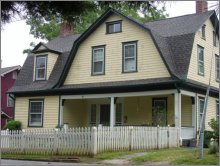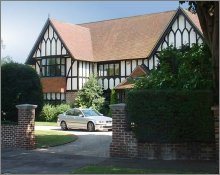Amazing Facts about U.S. Homes & Home Owners,
and the Most Common Styles of Home in the USA
by www.SixWise.com
Buying a home is an integral part of American culture, and
ranks way up there on most people's idea of the "American
Dream." Echoing this, the United States has about 3.75
million homes for sale, and nearly 69 percent of Americans
are homeowners, according to the U.S. Census Bureau.
|

The average price for a single-family home in the United
States is $306,258.
|
The average purchase price for a single-family home in October
2006 was $306,258 (down from $306,759 in October 2005), according
to The Federal Housing Finance Board. Although this represents
the first time in 12 years that the Board reported a drop
in the average price of a home, many still struggle with finding
affordable housing.
For instance, families who live in Dupage County, IL, and
earn the county's median income of $72,400, cannot afford
to purchase a single-family home at the median going rate
in the area, $343,500.
"Who needs affordable housing?" asked William Carroll,
president of Benedictine University in Lisle, IL. "Bookkeepers,
bank tellers, clergy, security guards, claims adjusters, teachers."
House Sizes Increasing, Households Decreasing
The average house in the United States is 2,349 square feet
-- more than double the average size in the 1950s. Ironically,
now that Americans have bigger houses, there are less people
in them. The average number of people living in U.S. households
is 2.6 people per home, a new low. (In 1915, for comparison,
the average number of people in a household was 4.5.)
Part of the reason for the shrinking household size, experts
say, are looser social restrictions that allow families to
move apart, and greater finances that give people the ability
to do so.
"It's the three Fs -- family, freedom, and finance,"
said Gil Troy, professor of American history at McGill University
in Montreal.
We Own Less of Our Homes
Another trend that's changing the face of American homeowners
is a decrease in home equity. The average homeowner now has
56.3 percent equity in their home, according to Demos, a public-interest
research group. In 1973, equity averaged out at 68.3 percent,
while in the 1950s equity in homes was at 80 percent or more.
|

The average household in the United States has only
2.6 people -- an all-time low.
|
Aside from the fact that Americans are taking
equity out of their homes (to the tune of $330 billion
from 2001 to 2004), homeowners are also putting less in to
begin with. It used to be that a standard down-payment on
a home was 20 percent. These days, less than half of homebuyers
put down 20 percent, according to a 2003 National Association
of Realtors (NAR) survey, and many opt for 100 percent --
or 103 percent -- financing.
What's Good About Owning a Home in the U.S.?
Of course, owning a home gives you pride of ownership, a
way to build equity and security for your family (the average
home increased its value by 88 percent over the last decade,
says NAR), and a place to call your own.
In other good news, most Americans are very happy with the
neighborhoods they live in, according to a 2005 American Housing
Survey. Over 70 percent of participants rated their neighborhood
an 8 or above (on a scale of 1 (worst) to 10 (best)). (The
region with the highest rate was the Midwest.)
|

Dutch Colonials are one of the most popular house styles
in the U.S.
|
Finally, owning a home gives you a chance to personalize
your environment, with paint, permanent fixtures, landscaping
… and housing style. According to W. Troy Swezey, realtor
and author of "A Guide to America's Most Common Home
Styles," the following house styles are among the most
prevalent in the United States:
-
Ranch: A one-story, long house (based on early
homes from the West and Southwest) that's among the most
popular in the country. Raised ranches, which have two
levels, are also popular.
-
Cape Cod: A small, 1.5-story symmetrical house
with a central entrance.
-
Georgian: A formal-looking rectangular house with
two or three stories and classic lines (popular in New
England). Georgians are usually made out of red brick
and have two chimneys.
-
Tudor: Based on English country cottages, tudors
have dark-colored wood timbering set against light-colored
stucco, and numerous windows.
-
Queen Anne/Victorian: Two-story houses based on
styles from Great Britain. They usually have porches along
the front and perhaps side of the house, peaked roofs
and ornamental wood trim (sometimes called "gingerbread").
-
Pueblo/Santa Fe Style: A one- or two-story house
with a flat roof (and protruding rounded beams) and stucco
exterior. Popular in the Southwest, these houses also
have covered patios and lots of tile.
-
Dutch Colonial: A two- or 2.5-story house with
a gambrel roof and outward-flaring eaves, typically made
out of brick or shingles.
-
New England Colonial: A 2.5-story home with a
gable roof and small-pane, double-hung windows, typically
with wood shutters.
-
Southern Colonial: A large two- or three-story
house with large front columns and a wide porch.
-
Split-levels: Houses that have one living level
a half a floor above the other (houses with three levels
are called tri-levels).
|

An example of the popular Tudor house style.
|
Recommended Reading
The
Home Construction Materials that Pose the Highest Health Risk
to You
Which
Home Renovations are Your Best Investments?
Sources
U.S.
Census Bureau
ChicagoTribune.com
November 30, 2006
MSNBC
CNNMoney.com
National
Association of Realtors
A
Guide to America's Most Common House Styles